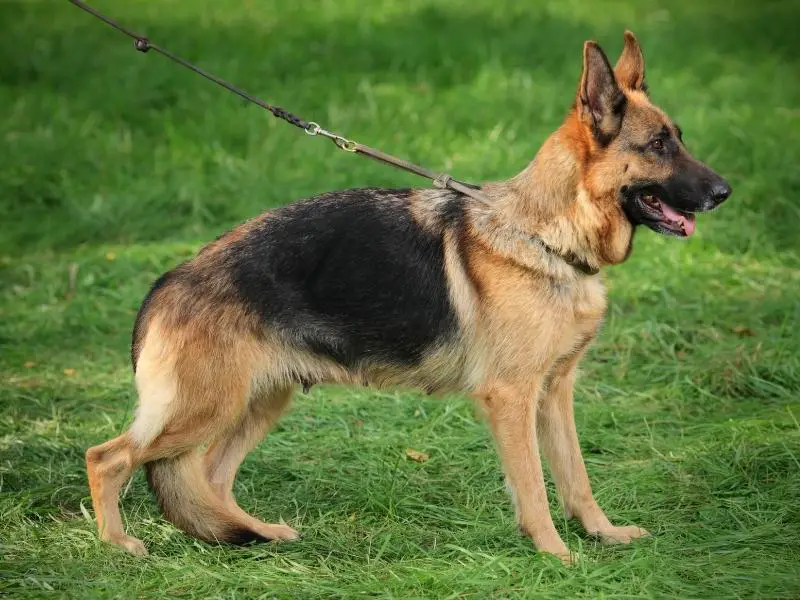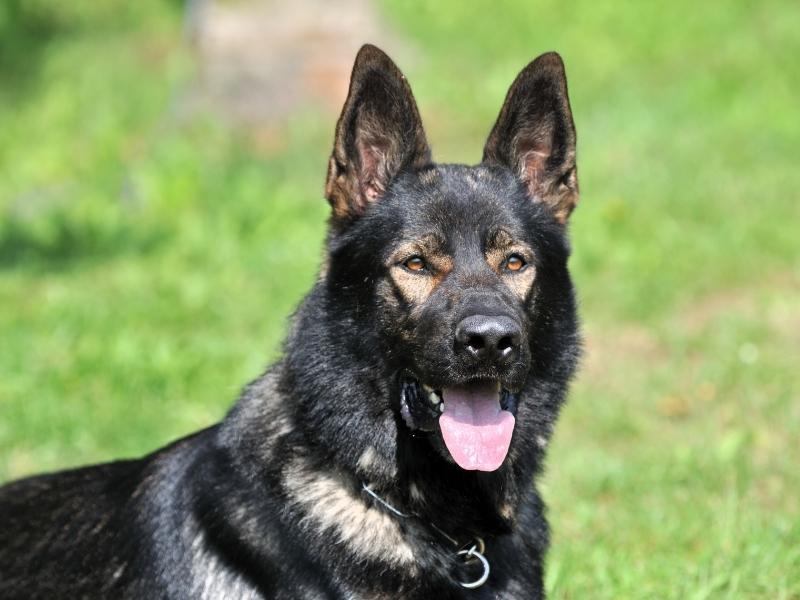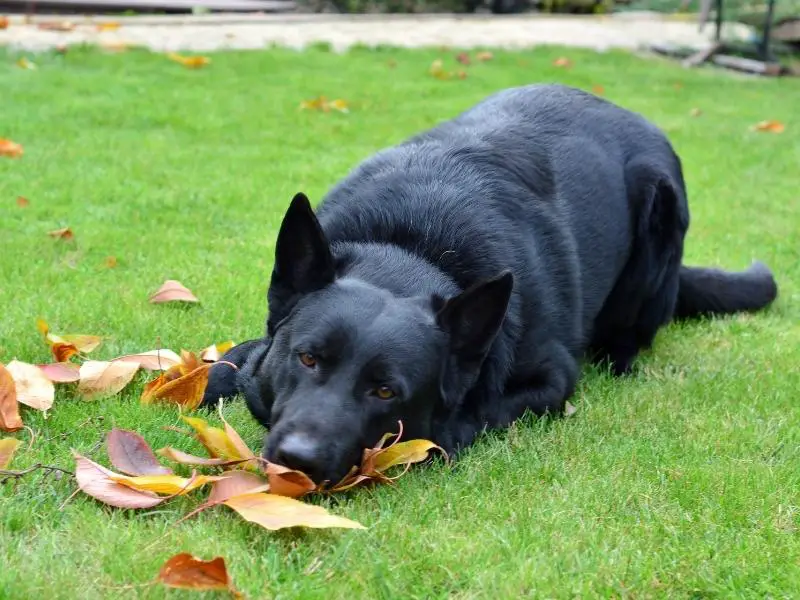When asked to describe German Shepherds, most people will say that they have black and tan coats. Though black and tan is the most commonly seen coat color in German Shepherds, these dogs can come in a variety of different colors.
So, what color are German Shepherd puppies? Most German Shepherd puppies are born black and have tan socks. At the age of six months, their coats start to change color and the tan becomes more pronounced by the week. Sable GSDs also start to change coat color when they are six months old and may continue to do so until the age of two years.
Read on to find out everything you need to know about the many different colors of German Shepherd dogs!
How Many Colors Are There in German Shepherds?
According to the breed standard, the German Shepherd dog varies in color, and most colors are permissible. The breed standard and major Kennel Clubs prefer strong rich colors over pale and washed-out colors (source).
There are 14 different colors of the German Shepherd, though some are more popular than others. The most common colors seen in German Shepherd dogs are black and tan, black and red, black and cream, and black.
Different German Shepherd Colors

From white to black, to silver to red, the German Shepherd comes in a variety of striking colors! While most of these colors can be registered with the American Kennel Club, washed-out colors, livers, and blues are serious faults and these dogs can’t compete at conformation dog shows.
Below, we will give you a full scoop on all different colors of German Shepherds to help you choose the perfect dog for you!
1. Black and Tan
Black and tan is the most common color combination seen in German Shepherds. Interestingly, the black and tan color is caused by a recessive gene.
GSDs with this color variation usually have a black saddle on their backs and they may also have a black mask on their faces. The tan coloring will be present on their chests, sides, necks, and their underbellies.
In puppies, the black and tan coat color appears more black than tan. However, as puppies grow their coats begin to become lighter until they gain their true tan coloration.
Black and tan is a classic color of working German Shepherds and is more prevalent in working lines.
2. Black and Red
The black and red color combination is also officially recognized by the American Kennel Club and is commonly seen in show lines.
Like black and tan German Shepherds, black and red GSDs will have a black saddle and a black mask. However, their sides, underbellies, and chests will be red in color.
While the red areas may sometimes be lighter in color, a rich and deep mahogany red-colored coat is preferred in dog shows.
3. Black and Cream
Black and cream is a lighter color variation of the popular black and tan German Shepherd coat color. GSDs with black and cream coats also have a black saddle on their backs and a black mask on their faces.
The light cream coloring is found on a dog’s chest, underbelly, and sides and is caused by a recessive gene. While black and cream German Shepherds can be registered by the AKC they aren’t allowed to take part in dog shows as their lighter-colored coat doesn’t meet the breed standard.
4. Black and Silver
Also known just as the silver German Shepherds, the black and silver GSDs are from working lines. Silver German Shepherds have similar markings as black and tan GSDs and sport a black saddle and a black facial mask.
Silver is a rare coat color for German Shepherds, so you may have a hard time adopting a black and silver GSD.
5. Sable
Sable coloring was present in the German Shepherd breed from the very beginning. In fact, the first German Shepherd named Horand von Grafrath had a sable coat.
Despite their rich history, sable German Shepherds aren’t nearly as popular as black and tan GSDs. Sable color is caused by a dominant agouti gene and is more commonly found in German Shepherd working lines.
6. Gray
Gray-colored German Shepherds are often confused with blue, silver, or even black German Shepherds. However, gray is a distinct color that can be registered with the American Kennel Club.
Like sable color, gray color is produced by a dominant gene and is much easier to breed for than black coloring which is caused by a recessive gene.
Gray German Shepherd puppies are born with blue eyes, like any other dog, but as they grow older their eyes become light brown or honey-colored. While these dogs are rarely seen at conformation shows, they are popular as pets due to their rare coloring.
7. Black
A dog must be completely black to be registered as a solid black German Shepherd. Sometimes, these dogs are born with small patches of white on their chests and paws, but those patches will disappear as the puppy grows.
Interestingly, the black color is caused by a recessive gene. To create a solid black GSD puppy, both parents must carry a black gene.
While black is a very rare color, it is officially recognized by the American Kennel Club and black German Shepherds can participate at conformation shows. Due to their rarity, black GSDs usually cost more than traditional black and tan German Shepherds.
8. Tan
Tan-colored German Shepherds have completely black muzzles and the rest of their coat is tan. These dogs are very rare and usually confused with Belgian Milionis.
Tan German Shepherds don’t conform to the breed standard and aren’t considered purebreds. However, that hasn’t stopped some breeders from breeding tan GSD and marketing them as a rare new breed.
9. White
White-colored German Shepherds are one of the most stunning color variations seen in this breed. Despite popular beliefs, white GSDs don’t suffer from albinism, and their white coats are caused by a recessive gene.
According to the breed standard, white GSD must be disqualified from conformation shows, but they can be registered with the AKC as purebreds. Most major Kennel Clubs, including the UK Kennel Club, don’t allow white German Shepherds to compete in dog shows.
However, some breeders and owners breed and show their white German Shepherds through various organizations that are committed to preserving this color variety.
10. Liver
The liver is another rare color variation seen in German Shepherd dogs. Liver coloring is caused by a recessive gene which means that both parents must carry the gene in order to pass this trait onto their offspring.
Unlike other German Shepherds, liver-colored GSDs don’t have a black mask and a black saddle. In fact, their entire coat has a rich, reddish-brown color and they usually have amber-colored eyes.
Liver German Shepherds are rarely seen at conformation shows since the washed-out color of their coats is considered a serious fault.
11. Blue
A blue German Shepherd is another rare and beautiful color variation within the GSD breed. These dogs usually have steel gray coats and amber, or golden-brown eyes.
This blue coloring is caused by a recessive dilution gene and is considered a serious fault in conformation shows. Although blue German Shepherds can’t compete, this color variation can be registered with the American Kennel Club.
12. Bi-Color
Bi-colored German Shepherds are considered a variation of the black and tan coat color. The majority of the coat is black and there are tan or brown markings on their feet, under the tail, and maybe a few markings on their faces.
A bi-color coat is caused by a recessive gene, so both parents need to carry the gene to produce bi-colored GSD puppies. Despite its rarity, this color is officially recognized by the American Kennel Club, and bi-colored GSDs can participate in dog shows.
13. Isabella
Isabella is a very unusual and rare color variation seen in German Shepherds that is the result of combining liver and blue dilution genes. The recessive dilution genes suppress black and chocolate-brown pigmentation giving the dog a pale and washed-out appearance.
Isabella German Shepherds aren’t recognized by any major kennel club, and they can’t compete in dog shows. This is also one of the rarest color varieties within the GSD breed so you may have a hard time locating a breeder that specializes in breeding isabella German Shepherds.
14. Panda
Panda German Shepherds are born with a rare genetic mutation that causes dominant white spotting that covers around 35% of a dog’s body (source). These German Shepherds have unique markings of black and white coloring on their faces that resemble the markings of the panda bear.
The KIT gene mutation that causes panda coloring is very rare, but some breeders are breeding for this coloring. Despite being purebreds, panda German Shepherds do not meet the breed standard and can’t compete at conformation shows.
What Is the Rarest Color in a German Shepherd?

Isabella is the rarest coat color in German Shepherds. This coloration is caused by genetically combining recessive liver and blue dilution genes.
Since the liver and blue dilution genes block all black and brown pigments, isabella German Shepherds don’t have any black pigment in their paw pads, eye rims, and noses and generally have light blue or hazel eyes.
What Color Are Most German Shepherds?
Black and tan is the most popular and most commonly seen color in German Shepherds. Dogs with this coloring have black masks on their faces and black saddles on their backs, while the rest of their bodies are covered in a rich tan color.
Surprisingly, sable color is dominant over the black and tan coloring. However, black and tan color is dominant over the more recessive solid black color.
What Is the Best Color for a German Shepherd?
If you plan on showing your German Shepherd the best color for them in black and red, black and tan, and sable. The breed standard states that most colors are permissible, but that dark, strong, and rich colors are preferred in the conformation shows.
If you don’t plan to show your German Shepherd, you can pick any one of many German Shepherd colors. Since coat color doesn’t have an effect on a dog’s health, temperament, or behavior you can’t make a bad choice whichever color you choose.
What Is the Original Color of a German Shepherd?
Sable is the original German Shepherd color. Horand von Grafrath, the progenitor of the entire German Shepherd breed was a sable colored dog.
When creating the German Shepherd breed, Max von Stephanitz didn’t breed for coat color, instead, he focused on the working abilities and soundness of the breed. Although the sable color is caused by a dominant gene, it’s not nearly as popular as black and tan and black and red coat colors.
Conclusion
When thinking about German Shepherds, most people picture a black and tan dog with a black saddle and black face mask. Black and tan is the most common and most popular German Shepherd color, but it isn’t the only one.
In fact, German Shepherds can come in a variety of different colors. The breed standard calls for strong, deep, and rich colors and considers pale, washed-out, livers, and blues a serious fault.
However, if you don’t plan on breeding or showing your German Shepherd, you can pick any coat color based on your preference.
Coat color doesn’t have any effect on a German Shepherd’s temperament, trainability, working ability, or health! So this isn’t something you have to worry about when choosing the perfect German Shepherd for your family.


0 Comments